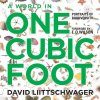![A World in One Cubic Foot A World in One Cubic Foot]()
Click to have a closer look
About this book
Customer reviews
Biography
Related titles
About this book
Twelve inches by twelve inches by twelve inches, the cubic foot is a relatively tiny unit of measure compared to the whole world. With every step, we disturb and move through cubic foot after cubic foot. But behold the cubic foot in nature – from coral reefs to cloud forests to tidal pools – even in that finite space you can see the multitude of creatures that make up a vibrant ecosystem.
For A World in One Cubic Foot, esteemed nature photographer David Liittschwager took a bright green metal cube – measuring precisely one cubic foot – and set it in various ecosystems around the world, from Costa Rica to Central Park. Working with local scientists, he measured what moved through that small space in a period of twenty-four hours. He then photographed the cube’s setting and the plant, animal, and insect life inside it – anything visible to the naked eye. The result is a stunning portrait of the amazing diversity that can be found in ecosystems around the globe. Many organisms captured in Liittschwager’s photographs have rarely, if ever, been presented in their full splendor to the general reader, and the singular beauty of these images evocatively conveys the richness of life around us and the essential need for its conservation. The breathtaking images are accompanied by equally engaging essays that speak to both the landscapes and the worlds contained within them, from distinguished contributors such as Elizabeth Kolbert and Alan Huffman, in addition to an introduction by E. O. Wilson. After encountering this book, you will never look at the tiniest sliver of your own backyard or neighborhood park the same way; instead, you will be stunned by the unexpected variety of species found in an area so small.
A World in One Cubic Foot puts the world accessibly in our hands and allows us to behold the magic of an ecosystem in miniature. Liittschwager’s awe-inspiring photographs take us to places both familiar and exotic and instill new awareness of the life that abounds all around.
Customer Reviews
Biography
David Liittschwager is a freelance photographer and a contributor to National Geographic and other magazines. His work has been exhibited at such institutions as the California Academy of Sciences and the American Museum of Natural History. He is the author of Skulls and coauthor of Archipelago: Portraits of Life in the World’s Most Remote Island Sanctuary, Remains of a Rainbow: Rare Plants and Animals of Hawaii, and Witness: Endangered Species of North America. Liittschwager also lectures and shows his work around the world in both fine art and natural history contexts.
Art / Photobook
By: David Liittschwager(Author), Edward O Wilson(Foreword By)
204 pages, 985 colour photos
"In a series of masterful, intimate portraits, David Liittschwager turns animals and plants found in a single cubic food of natural environment into objects of art, each more intricate and beautiful than the other. The richness of life documented here will astound you; the diversity of forms will leave you speechless."
- Piotr Naskrecki, author of Relics: Travels in Nature’s Time Machine
"A thrillingly beautiful, unique, wondrous evocation of life on earth – rich, abundant, largely unknown, but making our lives possible through the life activities of tens of millions of other organisms. This book is for everyone, from the youngest children on up, who would like to begin to understand the complexity and beauty of familiar places."
- Peter H. Raven, President Emeritus, Missouri Botanical Garden
"That this is a beautiful book is immediately obvious. But it’s also remarkably smart – a conceptual device that will change the way you see the world around you. I was absorbed in every page."
- Bill McKibben, author of Eaarth: Making a Life on a Tough New Planet
"Here is a world of small wonders – an entire universe of biodiversity captured in the confines of a cubic foot. David Liittschwager is a magician of the lens who works at the intersection of art and science."
- Chris Johns, Editor in Chief, National Geographic Magazine







































